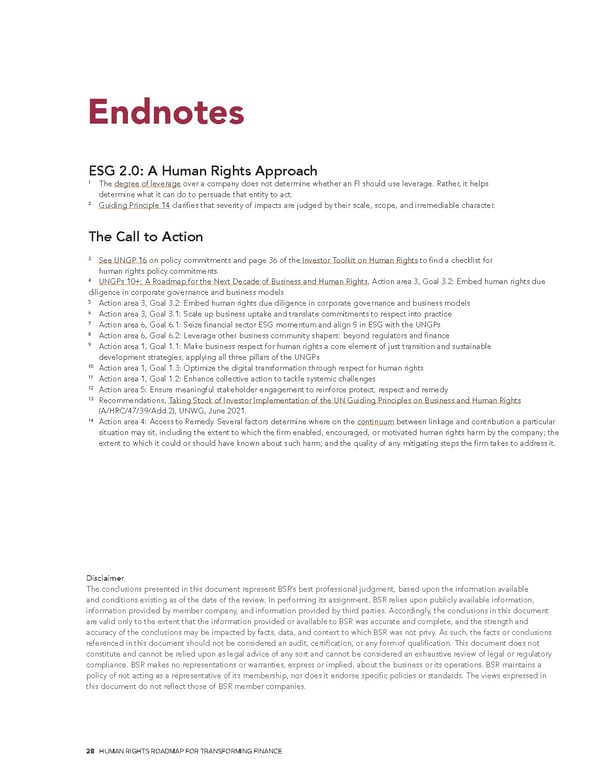Endnotes ESG 2.0: A Human Rights Approach 1 The degree of leverage over a company does not determine whether an FI should use leverage. Rather, it helps determine what it can do to persuade that entity to act. 2 Guiding Principle 14 clarifies that severity of impacts are judged by their scale, scope, and irremediable character. The Call to Action 3 See UNGP 16 on policy commitments and page 36 of the Investor Toolkit on Human Rights to find a checklist for human rights policy commitments. 4 UNGPs 10+: A Roadmap for the Next Decade of Business and Human Rights, Action area 3, Goal 3.2: Embed human rights due diligence in corporate governance and business models 5 Action area 3, Goal 3.2: Embed human rights due diligence in corporate governance and business models 6 Action area 3, Goal 3.1: Scale up business uptake and translate commitments to respect into practice 7 Action area 6, Goal 6.1: Seize financial sector ESG momentum and align S in ESG with the UNGPs 8 Action area 6, Goal 6.2: Leverage other business community shapers: beyond regulators and finance 9 Action area 1, Goal 1.1: Make business respect for human rights a core element of just transition and sustainable development strategies, applying all three pillars of the UNGPs 10 Action area 1, Goal 1.3: Optimize the digital transformation through respect for human rights 11 Action area 1, Goal 1.2: Enhance collective action to tackle systemic challenges 12 Action area 5: Ensure meaningful stakeholder engagement to reinforce protect, respect and remedy 13 Recommendations, Taking Stock of Investor Implementation of the UN Guiding Principles on Business and Human Rights (A/HRC/47/39/Add.2), UNWG, June 2021. 14 Action area 4: Access to Remedy. Several factors determine where on the continuum between linkage and contribution a particular situation may sit, including the extent to which the firm enabled, encouraged, or motivated human rights harm by the company; the extent to which it could or should have known about such harm; and the quality of any mitigating steps the firm takes to address it. Disclaimer The conclusions presented in this document represent BSR’s best professional judgment, based upon the information available and conditions existing as of the date of the review. In performing its assignment, BSR relies upon publicly available information, information provided by member company, and information provided by third parties. Accordingly, the conclusions in this document are valid only to the extent that the information provided or available to BSR was accurate and complete, and the strength and accuracy of the conclusions may be impacted by facts, data, and context to which BSR was not privy. As such, the facts or conclusions referenced in this document should not be considered an audit, certification, or any form of qualification. This document does not constitute and cannot be relied upon as legal advice of any sort and cannot be considered an exhaustive review of legal or regulatory compliance. BSR makes no representations or warranties, express or implied, about the business or its operations. BSR maintains a policy of not acting as a representative of its membership, nor does it endorse specific policies or standards. The views expressed in this document do not reflect those of BSR member companies. 28 HUMAN RIGHTS ROADMAP FOR TRANSFORMING FINANCE
 Human Rights Roadmap for Transforming Finance Page 27 Page 29
Human Rights Roadmap for Transforming Finance Page 27 Page 29